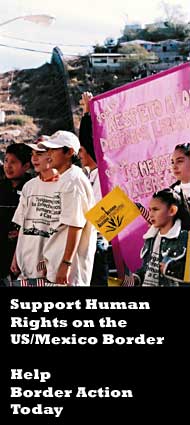A March to Nogales, Son.
We walked down the streets of Nogales in a contemplative mood. A loud hollow drumbet out the rythum of the march. We were marching for the No More Deaths Campaign against the militariazation of the border, unfair immigration, and economic policies. As we approached the official port of entry into downtown Nogales, Son. the somber mood of the march was elevated by the shouts, crys and whistles of our Mexican brothers and sisters on the other side of the border. They were holding up the port of entry into Nogales, AZ. They too were holding crosses remembering those who have lost thier life to the deserts of the Southwest. As we crossed, Mexican Officials, locals, tourists, children, street vendors, federales, and the Border Patrol look on while the two groups converged on the west side of the port of entry along the barrier fence and placed our crosses on the wall. The direct representation of policies designed to deter migrant workers; workers vital to the U.S. economy; workers simply searching for a better life. Some for themselves, but mostly for thier families. PLacing the crosses on the wall that directed thier course into the deadly harsh desert was a deeply satisfying action. I am sure that this act also had significant meaning to the other groups who were participating; Borderlinks, Humane Borders, Derechos Humanos, Border Action Network, Wingspan, Pan Left, Samaritans, los punks de Nogales, Son., the Yaqui indians among others.
The migrant trail that we are about to under take will be a symbolic gesture in the memorial of those who set out to cover the same ground and failed. To comemorate this symbolic act we gathered at the Central Nogales Plaza and were blessed by a yaqui ceremony where a single Yaqui dancer moved in rythm with the two violins and thumping harp. With shakers at this shines and bells at his waist he traced lines in plaza. A constellation of lines connected by coins offered to his feet. He danced facing the players encouraging them with his dance. A dance that blesses our journey and sends us south of Nogales to Altar, a major launching point for migrants expecting to cross the border, a starting point for those searching lost ones, and a place made important by the reponse of people to the immigration and economic policies of the U.S.
As we drive outh from Nogales we followed train tracks, that followed a river, that followed the land. The sun setting to our right painted the Sierra La Madera to the left of us pink and maroon. An tradition that developed in Northwestern Mexico was the creation of saints that emerged out of the relationship between the U.S. and Mexico. One of these saints was Juan Soldado, he was said to look after those who were wrongly accused and healed those who were ill. It seemed to me that Juan Soldado Santo had painted the mountains in such beautiful colors to leave touching images in the hearts of those who were migrating north. Also that the Sierra La Madera will warmly recieve them as they return to thier families in the future.
The migrant trail that we are about to under take will be a symbolic gesture in the memorial of those who set out to cover the same ground and failed. To comemorate this symbolic act we gathered at the Central Nogales Plaza and were blessed by a yaqui ceremony where a single Yaqui dancer moved in rythm with the two violins and thumping harp. With shakers at this shines and bells at his waist he traced lines in plaza. A constellation of lines connected by coins offered to his feet. He danced facing the players encouraging them with his dance. A dance that blesses our journey and sends us south of Nogales to Altar, a major launching point for migrants expecting to cross the border, a starting point for those searching lost ones, and a place made important by the reponse of people to the immigration and economic policies of the U.S.
As we drive outh from Nogales we followed train tracks, that followed a river, that followed the land. The sun setting to our right painted the Sierra La Madera to the left of us pink and maroon. An tradition that developed in Northwestern Mexico was the creation of saints that emerged out of the relationship between the U.S. and Mexico. One of these saints was Juan Soldado, he was said to look after those who were wrongly accused and healed those who were ill. It seemed to me that Juan Soldado Santo had painted the mountains in such beautiful colors to leave touching images in the hearts of those who were migrating north. Also that the Sierra La Madera will warmly recieve them as they return to thier families in the future.

